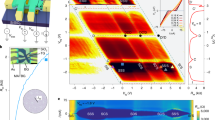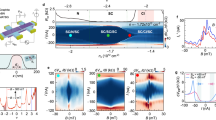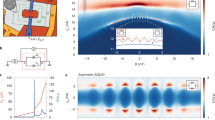Abstract
In situ electrostatic control of two-dimensional superconductivity1 is commonly limited due to large charge carrier densities, and gate-defined Josephson junctions are therefore rare2,3. Magic-angle twisted bilayer graphene (MATBG)4,5,6,7,8 has recently emerged as a versatile platform that combines metallic, superconducting, magnetic and insulating phases in a single crystal9,10,11,12,13,14. Although MATBG appears to be an ideal two-dimensional platform for gate-tunable superconductivity9,11,13, progress towards practical implementations has been hindered by the need for well-defined gated regions. Here we use multilayer gate technology to create a device based on two distinct phases in adjustable regions of MATBG. We electrostatically define the superconducting and insulating regions of a Josephson junction and observe tunable d.c. and a.c. Josephson effects15,16. The ability to tune the superconducting state within a single material circumvents interface and fabrication challenges, which are common in multimaterial nanostructures. This work is an initial step towards devices where gate-defined correlated states are connected in single-crystal nanostructures. We envision applications in superconducting electronics17,18 and quantum information technology19,20.
This is a preview of subscription content, access via your institution
Access options
Access Nature and 54 other Nature Portfolio journals
Get Nature+, our best-value online-access subscription
$29.99 / 30 days
cancel any time
Subscribe to this journal
Receive 12 print issues and online access
$259.00 per year
only $21.58 per issue
Buy this article
- Purchase on Springer Link
- Instant access to full article PDF
Prices may be subject to local taxes which are calculated during checkout




Similar content being viewed by others
Data availability
The data that support the findings of this study are available online through the ETH Research Collection38. This includes analysis and plotting scripts for Figs. 1–4 and Extended Data Figs. 2–4, and raw microscopy images for Fig. 1 and Extended Data Fig. 1. Source data are provided with this paper.
Code availability
The code used for the RCSJ simulations is online available through the ETH Research Collection38.
References
Saito, Y., Nojima, T. & Iwasa, Y. Highly crystalline 2D superconductors. Nat. Rev. Mater. 2, 16094 (2016).
Caviglia, A. D. et al. Electric field control of the LaAlO3/SrTiO3 interface ground state. Nature 456, 624–627 (2008).
Kononov, A. et al. One-dimensional edge transport in few-layer WTe2. Nano Lett. 20, 4228–4233 (2020).
Li, G. et al. Observation of van Hove singularities in twisted graphene layers. Nat. Phys. 6, 109–113 (2010).
Suárez Morell, E., Correa, J. D., Vargas, P., Pacheco, M. & Barticevic, Z. Flat bands in slightly twisted bilayer graphene: tight-binding calculations. Phys. Rev. B 82, 121407 (2010).
Bistritzer, R. & MacDonald, A. Moiré bands in twisted double-layer graphene. Proc. Natl Acad. Sci. USA 108, 12233–12237 (2011).
Nam, N. N. T. & Koshino, M. Lattice relaxation and energy band modulation in twisted bilayer graphene. Phys. Rev. B 96, 075311 (2017).
Guinea, F. & Walet, N. R. Continuum models for twisted bilayer graphene: effect of lattice deformation and hopping parameters. Phys. Rev. B 99, 205134 (2019).
Cao, Y. et al. Unconventional superconductivity in magic-angle graphene superlattices. Nature 556, 43–50 (2018).
Cao, Y. et al. Correlated insulator behaviour at half-filling in magic-angle graphene superlattices. Nature 556, 80–84 (2018).
Yankowitz, M. et al. Tuning superconductivity in twisted bilayer graphene. Science 363, 1059–1064 (2019).
Sharpe, A. L. et al. Emergent ferromagnetism near three-quarters filling in twisted bilayer graphene. Science 365, 605–608 (2019).
Lu, X. et al. Superconductors, orbital magnets and correlated states in magic-angle bilayer graphene. Nature 574, 653–657 (2019).
Nuckolls, K. P. et al. Strongly correlated Chern insulators in magic-angle twisted bilayer graphene. Nature 588, 610–615 (2020).
Josephson, B. Possible new effect in superconducting tunneling. Phys. Lett. 1, 251–253 (1962).
Shapiro, S. Josephson currents in superconducting tunneling: the effect of microwaves and other observations. Phys. Rev. Lett. 11, 80–82 (1963).
Tinkham, M. Introduction to Superconductivity (Courier, 2004).
Braginski, A. I. Superconductor electronics: status and outlook. J. Supercond. Nov. Magn. 32, 23–44 (2019).
Wendin, G. Quantum information processing with superconducting circuits: a review. Rep. Progr. Phys. 80, 106001 (2017).
Liu, X. & Hersam, M. C. 2D materials for quantum information science. Nat. Rev. Mater. 4, 669–684 (2019).
Li, C., Guéron, S., Chepelianskii, A. & Bouchiat, H. Full range of proximity effect probed with superconductor/graphene/superconductor junctions. Phys. Rev. B 94, 115405 (2016).
Calado, V. E. et al. Ballistic Josephson junctions in edge-contacted graphene. Nat. Nanotechnol. 10, 761–764 (2015).
Xie, M. & MacDonald, A. H. Weak-field Hall resistivity and spin/valley flavor symmetry breaking in MAtBG. Preprint at https://arxiv.org/abs/2010.07928 (2020).
Mortensen, N. A., Flensberg, K. & Jauho, A.-P. Angle dependence of Andreev scattering at semiconductor–superconductor interfaces. Phys. Rev. B 59, 10176–10182 (1999).
Uri, A. et al. Mapping the twist-angle disorder and Landau levels in magic-angle graphene. Nature 581, 47–52 (2020).
Julku, A., Peltonen, T. J., Liang, L., Heikkilä, T. T. & Törmä, P. Superfluid weight and Berezinskii–Kosterlitz–Thouless transition temperature of twisted bilayer graphene. Phys. Rev. B 101, 060505 (2020).
Olyaei, H. Z., Amorim, B., Ribeiro, P. & Castro, E. V. Ballistic charge transport in twisted bilayer graphene. Preprint at https://arxiv.org/abs/2007.14498 (2020).
Bocquillon, E. et al. Gapless Andreev bound states in the quantum spin Hall insulator HgTe. Nat. Nanotechnol. 12, 137–143 (2017).
Nanda, G. et al. Current-phase relation of ballistic graphene Josephson junctions. Nano Lett. 17, 3396–3401 (2017).
Virtanen, P., Heikkilä, T. T., Bergeret, F. S. & Cuevas, J. C. Theory of microwave-assisted supercurrent in diffusive SNS junctions. Phys. Rev. Lett. 104, 247003 (2010).
Moshe, M., Kogan, V. G. & Mints, R. G. Edge-type Josephson junctions in narrow thin-film strips. Phys. Rev. B 78, 020510 (2008).
Rodan-Legrain, D. et al. Highly tunable junctions and non-local Josephson effect in magic-angle graphene tunnelling devices. Nat. Nanotechnol. https://doi.org/10.1038/s41565-021-00894-4 (2021)
Kim, K. et al. Van der Waals heterostructures with high accuracy rotational alignment. Nano Lett. 16, 1989–1995 (2016).
Wang, L. et al. One-dimensional electrical contact to a two-dimensional material. Science 342, 614–617 (2013).
Orlando, T. P. & Delin, K. A. Foundations of Applied Superconductivity (Addison Wesley, 1991).
Russer, P. Influence of microwave radiation on current–voltage characteristic of superconducting weak links. J. Appl. Phys. 43, 2008–2010 (1972).
Le Calvez, K. et al. Joule overheating poisons the fractional ac Josephson effect in topological Josephson junctions. Commun. Phys. 2, 4 (2019).
de Vries, F. K. et al. Data repository: Gate-defined Josephson junctions in magic-angle twisted bilayer graphene. https://doi.org/10.3929/ethz-b-000463616 (2021).
Efros, A. L. & Shklovskii, B. I. Coulomb gap and low temperature conductivity of disordered systems. J. Phys. C Solid State Phys. 8, L49–L51 (1975).
Ingold, G.-L. & Nazarov, Y. V. Charge Tunneling Rates in Ultrasmall Junctions, 21–107 (Springer, 1992).
Acknowledgements
We thank B. Kratochwil, P. Maerki and the staff of the ETH clean-room facility FIRST for technical support, and T. Wolf and members of the quantum e-leaps consortium for useful discussions. We acknowledge support from the Graphene Flagship and from the European Union’s Horizon 2020 research and innovation programme under grant agreement number 862660/QUANTUM E LEAPS. K.W. and T.T. acknowledge support from the Elemental Strategy Initiative conducted by the MEXT, Japan, grant number JPMXP0112101001, JSPS KAKENHI grant number JP20H00354 and the CREST (JPMJCR15F3), JST. E.P acknowledges support of a fellowship from ‘la Caixa’ Foundation (ID 100010434) under fellowship code LCF/BQ/EU19/11710062. The funders had no role in study design, data collection and analysis, decision to publish or preparation of the manuscript.
Author information
Authors and Affiliations
Contributions
E.P. made the stack and P.R. fabricated the device, with assistance from G.Z. T.T. and K.W. supplied the hBN crystals. F.K.d.V and E.P. performed the measurements. E.P. performed the simulations. T.I., K.E. and P.R. supervised the project. F.K.d.V., P.R. and E.P. wrote the manuscript with comments from all authors.
Corresponding authors
Ethics declarations
Competing interests
The authors declare no competing interests.
Additional information
Peer review information Nature Nanotechnology thanks the anonymous reviewers for their contribution to the peer review of this work.
Publisher’s note Springer Nature remains neutral with regard to jurisdictional claims in published maps and institutional affiliations.
Extended data
Extended Data Fig. 1 Fabrication images of the device.
a, Optical image before fabrication, the red shaded area is the etch mask. The device is placed carefully in-between the bubbles in the MATBG. b, Optical image before and c after deposition of the central gate electrodes. The measured device is marked with a dashed square. In transport, we find that the lower device has a larger twist angle (θ = 1. 5∘) and does not show superconductivity. d, Scanning electron microscopy image of a similar device (not titled). The narrow gap between the L and R gates is well resolved, allowing us to identify a typical length of 100 nm. e, Schematic cross-section of the device, all layers are to scale. From this we estimate that the size of the gated region below gate C can vary by ± 10 nm.
Extended Data Fig. 2 Characterisation of superconductivity: critical current dependence on temperature and magnetic field.
a, Ic versus B⊥ and T. The critical magnetic field is extracted and plotted as red crosses. A fit with the Ginzburg–Landau equation B⊥,c = (ℏ/2e)/ξ2(1 − T/Tc) for two-dimensional superconductors17 provides us with the estimate of the superconducting coherence length ξ indicated. b, Resistance R as a function of bulk density n and T. The two superconducting domes at n = ± 1.5 × 1012cm−2 show up. c,f, R as a function of I and B⊥ at T = 25 mK. d,g, R as a function of I and T at B⊥ = 0 T. e,h, line traces from d,g at different T as indicated. While c-e correspond to n = − 1.5 × 1012cm−2 f-h are taken at n = 1.5 × 1012cm−2. The step around zero I in e,h for T = 50 mK could be the combination of Coulomb effects in disordered systems39, and dynamical Coulomb blockade in the JJ40. Since the step vanishes at increased temperature, and before the superconductivity is suppressed, it is not a property of the superconducting state itself.
Extended Data Fig. 3 Fabry-Pérot oscillations.
a, Zoom in on R versus I and nj for the JJ of 100 nm and nl = − 1.5 × 1012cm−2, and b Is versus nj extracted from a and a smoothed curve fit through it. Is is roughly modulated following \(\sqrt{{n}_{j}-{n}_{0}}\) with n0 = − 4.1 × 1012cm−2. The conductance G in c, recorded at I = 350 nA, behaves in a similar fashion. Local maximum values of Ic and G occur if the Fabry-Pérot condition is fulfilled. For constructive interference the condition reads iλ = 2L, where i is an integer, λ the charge carrier wavelength and L the cavity length. The condition can be expressed as a function of density by using λ = 2π/k and \(k=\sqrt{4/g}{n}_{i}/\pi\), giving ni = ± πi2/L2(4/g) with g = 4. The observed maxima in Ic and G in b,c are well captured by setting I = 75 nm (indicated by orange dotted lines) which is in good a agreement with Lj. d, R(nj, nl) at I = 350 nA. The Fabry-Pérot oscillations show dependence on nl, confirming that the oscillations originate from a region below gate C. This is confirmed in e where line traces R(nj) for different nl are plotted, as well as lines at which we expect constructive Fabry-Pérot oscillations, indicated by orange dotted lines. f, The differential conductance (dI/dV) as a function of perpendicular magnetic field B and nj, measured at T = 1.4 K is plotted. The Fabry-Pérot pick up an Aharanov-Bohm phase, and, depending on the band topology, a Berry phase, leading to a quadratic bending as a function of n, B. Finally, we see that for all nj < ns, Fabry-Pérot oscillations show up.
Extended Data Fig. 4 Line traces of Shapiro steps at different frequencies.
a,b, V as a function of I show Shapiro step line traces for the JJ of 100 nm with nj = − 4.6 × 1012cm−2 and nl = − 1.5 × 1012cm−2 for the frequencies indicated. The traces are offset by 10 nA and taken at \({P}_{rf}^{1/2}=0,0.015,0.022,0.028,0.035\) for a, and \({P}_{rf}^{1/2}=0,0.005,0.009,0.014,0.019\) for b. The orange dashed lines mark the expected steps at multiples of ΔV = hfrf/2e.
Source data
Source Data Fig. 1
Original scanning slectron micrograph for panel b. Numerical data plotted in panels c,d.
Source Data Fig. 2
Numerical data of all panels in the figure.
Source Data Fig. 3
Numerical data of all panels in the figure.
Source Data Fig. 4
Numerical data of all panels in the figure, except for d (schematic)
Source Data Extended Data Fig. 1
Numerical data of all panels in the figure.
Source Data Extended Data Fig. 2
Original optical images and scanning electron micrograph.
Source Data Extended Data Fig. 3
Numerical data of all panels in the figure.
Source Data Extended Data Fig. 4
Numerical data of all panels in the figure.
Rights and permissions
About this article
Cite this article
de Vries, F.K., Portolés, E., Zheng, G. et al. Gate-defined Josephson junctions in magic-angle twisted bilayer graphene. Nat. Nanotechnol. 16, 760–763 (2021). https://doi.org/10.1038/s41565-021-00896-2
Received:
Accepted:
Published:
Issue Date:
DOI: https://doi.org/10.1038/s41565-021-00896-2
This article is cited by
-
Tunable quantum interferometer for correlated moiré electrons
Nature Communications (2024)
-
The Roadmap of 2D Materials and Devices Toward Chips
Nano-Micro Letters (2024)
-
Probing miniband structure and Hofstadter butterfly in gated graphene superlattices via magnetotransport
npj 2D Materials and Applications (2023)
-
Electrical switching of a bistable moiré superconductor
Nature Nanotechnology (2023)
-
The superconducting diode effect
Nature Reviews Physics (2023)



